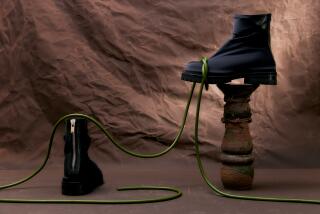Gizmos Galore
- Share via
Many of the high-tech features once exclusive to luxury cars have lately trickled down to more modestly priced mainstream models. Devices and systems that previously helped define upscale vehicles are now widely available in all but the most basic of rides.
“You can get a back-up camera, for example, in virtually any vehicle these days,” said Joe Wiesenfelder, senior editor at Cars.com. “Ambient lighting is another one. This indirect mood lighting wowed us in the Mercedes-Benz S-Class, and now it can be found in some models from Ford, Mini and others. The same can be said of radar-based blind-spot monitoring systems and automatic-parking features, which now come from more modest brands, including Ford.”
This proliferation of technology has pressured luxury brands to justify their higher prices with even glitzier gizmos. They’ve responded with an astonishing array of innovations in the fields of safety, comfort, convenience and connectivity. As well as enhancing the driving experience, these provide dealers with selling points — and buyers with bragging rights.
“Luxury cars still seem to corner the market on systems that use forward-looking radar. It provides adaptive cruise control, which maintains following distance from the car in front of you,” Wiesenfelder said. “Another big one is collision avoidance — or collision mitigation — systems.… Acura was the first with the RL sedan, though they get no credit for it because Mercedes started doing it, too.”
Now available on their ZDX and MDX crossovers, as well as the RL, Acura’s Collision Mitigation Braking System monitors the likelihood of a rear-end collision and uses audio, visual and tactile signals — warning lights appear and the driver’s seatbelt begins to tighten — to alert drivers if one appears imminent.
Mercedes-Benz’s Distronic Plus adaptive cruise-control system uses radar sensors to help maintain a preset following distance behind the vehicle ahead and can actually brake the car to a full stop in certain circumstances. If a driver doesn’t brake hard enough in an emergency situation (which simulator tests suggest is often the case), Mercedes’ Brake Assist Plus measures the distance to the vehicle ahead and seamlessly adjusts the brake pressure.
BMW takes things a step further. In the unfortunate event that a collision proves unavoidable, BMW’s Enhanced Automatic Collision Notification can detect the impact and notify local authorities.
“Night vision is still exclusive to luxury, namely BMW and Mercedes — though Cadillac was the first to implement it a decade ago,” Wiesenfelder noted. “The idea is it sees farther and wider than your headlights are allowed to shine, and because it’s infrared — based on heat — pedestrians and animals really stand out in the display. It’s most useful away from urban centers, where it’s truly dark.”
Also useful after dark are BMW’s automatic high beams and Mercedes’ similar Adaptive High Beam Assist — basically systems that keep the brights on for the longest possible time without dazzling other drivers.
Volvo, the Swedish manufacturer renowned for state-of-the-art safety, will offer Pedestrian Detection in its 2011 S60 executive sedan. This radar- and camera-based system can detect pedestrians in front of the car, sound a warning and automatically activate full braking if the driver fails to respond in time. The wide field of vision of its newly developed dual-mode radar even allows people about to step into the roadway to be detected.
“In the ‘unique and questionable’ department, the Mercedes S- and CL- classes offer as options front seats that change shape as you turn,” Wiesenfelder said. “Basically, if you turn left, the backrests’ right-side bolsters push forward to hold you in place.… You can choose how much they push, and you can turn it off for either seat, too.”
Perhaps even more outlandish (but potentially life-saving) are the explosive bolts that automatically detach the gullwing doors of the Mercedes-Benz SLS AMG supercar in the event of a rollover. A useful piece of Mercedes technology is its new Splitview (a $700 option in the S-Class sedans CL-Class coupes), a clever bit of technology that allows the driver to view navigation, radio or vehicle menu displays while the passenger watches a movie — all on the same screen.
If all this high-tech has your head spinning, Hyundai is here to help. The Korean company noticed that automotive owner’s manuals have vastly expanded to keep pace with today’s complicated cars. For example, a recent edition of the Lexus LS manual totaled 1,091 pages — not much less than the 1,225 pages of Tolstoy’s famously lengthy “War and Peace.” So for its all-new 2011 premium luxury Equus sedan, which goes on sale stateside this month, Hyundai has teamed with Apple to develop an interactive owner’s manual application for iPad and iPhone.
—Paul Rogers, Custom Publishing Writer






